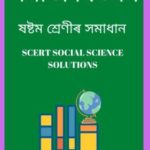SEBA Class 6 Social Science Chapter 9 What , Where, When And Why Solutions in English Medium to each chapter is provided in the list so that you can easily browse throughout different chapters SEBA Class 6 Social Science Chapter 9 What , Where, When And Why Notes and select need one.
SEBA Class 6 Social Science Chapter 9 What , Where, When And Why
Also, you can read the SCERT book online in these sections Solutions by Expert Teachers as per SCERT (CBSE) Book guidelines. These solutions are part of SCERT All Subject Solutions. Here we have given Geography, History, Political Science and Economics Assam Board SEBA Class 6 Social Science Chapter 9 What , Where, When And Why Question Answer for All Subject, You can practice these here.
What , Where, When And Why
Chapter – 9
| History |
Exercise
1. Write answer:
(a) What is history?
Ans: History is the study and narration of past events, focusing on human activities, societies, and civilizations, and their impact on the present and future. It involves examining and interpreting evidence to understand and document the development of cultures, nations, and the world over time.
(b) Why is it that history and story do not mean the same?
Ans: History and story do not mean the same because “history” refers to factual, academic, and non-fictional accounts of past events, focusing on evidence and accuracy. while “Story” is more connected to the imagination, to friction and it is narrative.
(c) What are the sources of studying history?
Ans: There are four sources – oral sources,visual sources archaeological and literary.
(d) Are the Vedas, Puranas, Mahabharata, etc. sources of studying history? If yes, to which category do they belong?
Ans: Yes, the Vedas, Puranas, Mahabharata, and other similar texts can be used as sources for studying history. They belong to the category of literary sources, specifically religious and epic literature. These texts provide insights into the socio-cultural, religious, and political life of ancient India,
(e) What is the importance of studying history at present day?
Ans: Studying history allows us to understand the past in order to better comprehend the present. we learn how we got where we are, and why we live the way we do. It’s the study of us—of humans and our place in an ever changing world. history helps us learn from past successes and failures, avoiding repetitive mistakes and guiding us toward progress.
(f) What is the difference between ‘Buranji’ and Ithihasa?
Ans: The difference between ‘Buranji’ and Ithihasa are:
| Buranjis | Ithihasa |
| Buranjis are historical chronicles from the Ahom kingdom, originally written in the Ahom language and later in Assamese. They document the history, culture, and administration of the Ahom dynasty. | In Sanskrit, Itihasa means history. Itihasa in Sanskrit means “thus it happened” and refers to epic narratives recounting historical events, legends, and moral teachings, such as the Ramayana and Mahabharata in Hindu tradition |
| Buranjis serve as detailed historical records, providing accounts of local events, rulers, and socio-political changes. | Itihasas not only recount historical events but also convey moral, ethical, and spiritual lessons, intertwining history with mythology and philosophy. |
2. Discuss in group any of the story or folktale that you know.
Ans: Three little pigs each build a house: one of straw, one of sticks, and one of bricks. A big bad wolf blows down the straw and stick houses but cannot destroy the brick house. The pigs who built the sturdy brick house are safe, while the others face danger.
Discussion Points:
Themes: The story highlights the importance of hard work and careful planning.
Moral: It teaches that preparation and effort lead to lasting success and protection against challenges.
Characters: The pigs symbolize different approaches to work, while the wolf represents external threats.
3. Group Activity:
(a) What changes have taken place in your locality over the last 10 years? Collect some data on that and prepare an assignment.
Ans: Infrastructure: New roads and improved public transport.
Housing: Increased residential developments and high-rise buildings.
Commercial Growth: Rise in shopping centers and restaurants.
Technology: Expansion of internet services and digital facilities.
Environment: New parks and green spaces.
(b) Is there any historical source in your district? If yes, collect data on that and discuss it in class. (take the help of your teacher if needed).
Ans: Students, do yourself.
(c) Arrange an excursion to a historical place.
Ans: Students do yourself.

Hi! my Name is Parimal Roy. I have completed my Bachelor’s degree in Philosophy (B.A.) from Silapathar General College. Currently, I am working as an HR Manager at Dev Library. It is a website that provides study materials for students from Class 3 to 12, including SCERT and NCERT notes. It also offers resources for BA, B.Com, B.Sc, and Computer Science, along with postgraduate notes. Besides study materials, the website has novels, eBooks, health and finance articles, biographies, quotes, and more.




